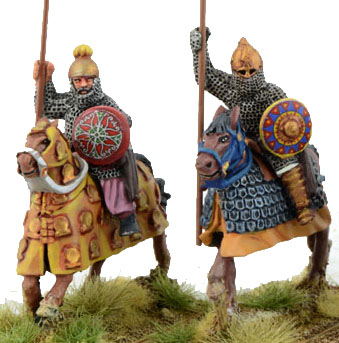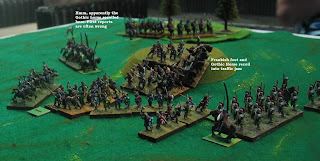I am currently re-reading Peter Crawford’s “The War of the Three
Gods”, about the last Roman-Persian war and the subsequent whipping that both
of those powers then took at the hands of the Muslim Arabs. I’ve just finished
the first part and am writing this to summarize the events chronologically for
my own use and hopefully as an introduction for those who don’t know this period.
The war was between the Roman Empire and Sassanid Persia, whose state religion
was Zoroastrianism. They didn’t worship fire but the extensive use of fire in
their temples convinced non-believers otherwise. The western part of the Roman
Empire - including Rome - had gone under over a century before, though much had
been reconquered. The Empire was Christian, including all the baggage between
Orthodox Christianity and heretics that came with it. My outline of the war is
cursory and incomplete. To those already deep into this period, have mercy.
Back in the day, when I worked in a library (and got to read most
of the new history books first) I read a stirring account of the last
Roman-Persian war. It said heroic Emperor Heraclius overthrew the evil
usurper Phocas, turned the disastrous war around, rallying his people in a
virtual crusade. Crawford’s book doesn’t worship Heraclius, noting that he
suffered a decade of defeats, losing major parts of the Empire before his
counterattack on Persia. He did finally turn the war around, just in time to
serve up two exhausted powers to the Muslim jihad. The current book is a drier
read than the one back in the 70s (cannot recall the name), wnich featured the
super-hero Heraclius dispatching Persian champions and generals in single combat.
Rome and the Sassanids had been waging war against each other sporadically since the Sassanids overthrew the Parthians in the early 3rd Century. Fairly evenly matched, the wars usually resulted in minor changes to territory in Armenia or Mesopotamia. They also waged proxy wars through the Arab Ghassanids (Pro-Roman and Christian) and Lakhmids (Pro-Persian). Both Rome and Persia had plenty of internal problems with civil wars and usurpations. The key to the last war arises from the previous war (572-591). In 590 the Sassanid Spabed (general) Bahram rose against the aging Shah Hormizd IV. Replacing the Shah with his vigorous son Khusro II (AKA Chosroes, Khusrau, etc.) wasn’t enough. The young Shah fled to Roman Syria. Bahram crowned himself Bahram VI Chobin. The soldier-emperor Maurice (AKA Mauricius) invited the exiled Shah to Constantinople. With the substantial Roman force loaned him added to his own followers, Khusro regained his throne, chasing Bahram into exile and an early death. Khusro signed a treaty that was very favorable to the Romans. For a decade, the truce held and both put their energy into shoring up their other frontiers, Rome on the Danube against Avars and Slavs, Sassanids in the Caucasus against Turks.
Maurice tried to cut the cost of the expensive military. Instead, he was deposed by an army mutiny. A soldier named Phocas seized the throne and had Maurice and all his family slain. To Khusro this was cause for war delivered on a silver plate. He declared he would avenge his benefactor. And in the process reverse the overly generous previous treaty. So began the final war between these powers in 602. It would rage on for 26 years.
The Sassanids made slow
progress, each fort or city requiring a lengthy siege. Phocas did little to stop this slow rot. Instead he was busy stomping out internal plots, executing any deemed
loyal to the previous regime.
In 608 Heraclius, governor of Roman Africa from Carthage rose against Phocas. Two years of civil war saw Phocas dethroned and executed in his turn, with Heraclius taking the throne in 610. During this time the Sassanids had continued capturing cites, severely compromising the Roman defensive system. Things began to collapse early in the reign of Heraclius. Mesopotamia, Armenia, Syria and Palestine fell to the Persians. Jerusalem fell, Christian morale sinking as the True Cross and other relics were carried off. An early attempt by Heraclius to stem the tide saw him and his army defeated. Heraclius adopted a cautious strategy, refusing to fight the enemy in the open field, now relying on raids, then sheltering behind fortress walls. Slowly he built the battered Roman army back up. This was done without the wealth of the eastern provinces lost to Sassanid occupation. The Persians did not squeeze as much wealth from the provinces as the Romans knew how to. Persian policy was to be tolerant of the local Christians, Monophysite heretics who had suffered under Roman rule. They were more tolerant of the Jews than the Romans had been. The Persians weren’t loved by all but there was not much in the way of local resistance either. The complete conquest of the Roman Empire seemed within reach.
Next the Persians conquered Egypt,
the source of grain for Constantinople. The Avars invaded the Balkans and besieged
the capitol. A Persian army invaded Anatolia and watched the Avar siege from
across the Bosphorus. The superior Roman navy crushed the few attempts by the
Persians to send aid cross the water to the siege. Eventually the Avar force,
having lost heavily attacking the triple line of land walls, gave up. The Persian army
retired to Syria. Heraclius now marched east through Armenia, sacking Sassanid cities and temples. Three Sassanid armies tried to corner him. Using
his Arab light cavalry scouts effectively to detect this scheme, he beat each of the three armies in
turn and then escaped back to Anatolia before they could combine against him.
One of the Sassanid generals had died in battle. Another critical general Shahrbaraz came under suspicion from the Shah, who sent orders to have the general slain. The Romans intercepted the order and showed it to Shahrbaraz. That general then doctored the order to include 400 of his officers on the death list before revealing it to them. Convinced, they decided to follow him as he led his army to sit out the rest of the war in Syria, waiting to see the result and in time moving on the throne.
Having neutralized the toughest enemy force, Heraclius marched
back east and in the next two years inflicted defeats on enemy forces sent
against him, sacked cities and spoiled major Zoroastrian temples, heading for
the heart of Persia. He was stopped from taking the capitol Ctesiphon when the
bridge across a canal was burned, but Persian morale hit rock bottom. Khusro
was overthrown and slain by his own aristocrats. A treaty ended the war with
both sides going back to their original positions before the war. It took a
while for the forces to untangle themselves, with both sides having their best
forces deep in enemy territory. But it was done, the war ending in 628, both
sides having poured blood and treasure out in torrents, both having had hostile
armies lay waste their richest provinces. The exhausted powers licked their
wounds. Sassanid Persia descended into chaos, 11 shahs occupying the throne
after Khusro, before the last Sassanid Shah took power in 633. In
Constantinople, Heraclius founded a dynasty and lived long enough to see the
Muslims undo much of his work.
Muhammed died in 632. The next year saw the
first Muslim Arab invasion of Iraq under Khalid, a skilled commander. More
attacks would follow, pouring out of the desert to wage jihad against the infidels,
eradicating the Sassanid dynasty. They stripped the Mideastern and African
provinces from the Roman Empire, reducing it from Mediterranean super-power to a mere regional
player. Historians call that lesser power the Byzantine Empire. They called
themselves Romans to the end, some 8 centuries later.




























